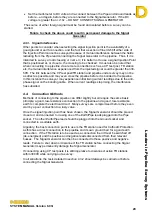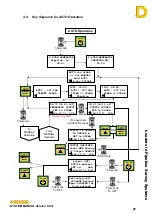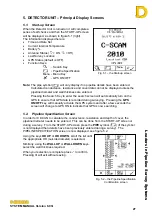
Leaders in Pipelin
e Survey Systems
C
C
C
-
-
-
S
S
S
C
C
C
A
A
A
N
N
N
2
2
2
0
0
0
1
1
1
0
0
0
SYSTEM MANUAL Version 6.03i
32
6.2.2. Survey Procedure Overview
To carry out the above surveys, the following procedure is followed. These procedures
are explained in more detail in the appropriate chapter listed:
Survey Planning
It is always advisable to gather as much information as
possible about the pipeline being surveyed before a
survey starts.
Signal Injection
Connect the Signal Generator to the pipeline being
surveyed using the methods described in this manual.
Ensure that the signal cannot escape to, or enter from,
another pipeline.
Locate Pipeline
Use the SEARCH screen to locate the position of the
pipeline
Locate Overhead
Use the OVERHEAD bars to accurately locate the
position above the pipeline
Record Sample
Take a reading from the OVERHEAD position and store
the reading in the Detector’s memory.
Repeat until low
signal
Continue taking readings at appropriate intervals until
the signal on the pipeline becomes too low.
Move Generator
To continue surveying the pipeline, the Signal
Generator will need to be moved and a new survey
started. The new injection point should allow for an
overlap with the previous survey to ensure that no part
of the pipeline is left un-surveyed.
Download Data
Once the area to be surveyed has been completed the
data can be downloaded to computer using Dynalog’s
DCAPP software.
Analyse & Report
Once downloaded the data can be analysed using
DCAPP and either printer or exported for use in other
programs or documents/reports.
Clear C-SCAN
Once the data has been successfully downloaded the
detector memory can be cleared before the next survey.
6.3. Survey Planning
No two pipelines will produce identical survey results because of variations in size,
coating, age, soil conditions, etc., but Dynalog has built up field experience over an
extended series of trials which can provide initial guidance on survey planning and
interpretation of the results obtained. As the Surveyor acquires his own field experience,
particularly with repeat surveys on the same pipelines, he will refine and add to these
techniques and develop additional skills in interpretation.
6.3.1. Preparation
Before starting any survey, it is advisable to assemble as much information as possible
about the pipeline. This should include a large scale map (1:5000 or better) showing the
location of the pipeline and any other pipelines in the area, the approximate positions of all
branches, valves, CP Test Posts, anodes, sleeves, and any other relevant information.
The Surveyor should also review the available data on the pipeline’s history: date of
installation, nature of wrap or coating, all recent survey reports (including ‘Pearson’
surveys and CIPS potential surveys), and when and where the line has been excavated
and the coating repaired over the last five years or so, together with reports on defects
found when excavating.
Although optional, it is good practice to manually record all samples on a log sheet. A log
sheet template has been included in Appendix 2 for printing.
















































